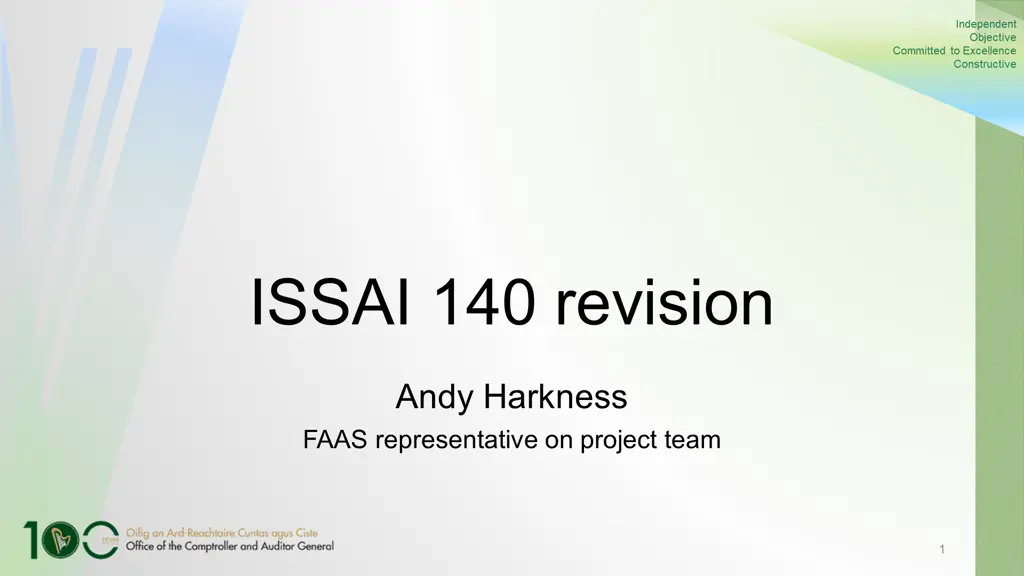ISSAI 140 revision
The revision of ISSAI 140 to align with ISQM 1, key principles, and quality management standards for SAIs. Understand the differences between ISQC1 and ISQM1 and the process of updating quality control standards.
Uploaded on Dec 23, 2023 | 12 Views
Download Presentation

Please find below an Image/Link to download the presentation.
The content on the website is provided AS IS for your information and personal use only. It may not be sold, licensed, or shared on other websites without obtaining consent from the author.If you encounter any issues during the download, it is possible that the publisher has removed the file from their server.
You are allowed to download the files provided on this website for personal or commercial use, subject to the condition that they are used lawfully. All files are the property of their respective owners.
The content on the website is provided AS IS for your information and personal use only. It may not be sold, licensed, or shared on other websites without obtaining consent from the author.
E N D
Presentation Transcript
Independent Objective Committed to Excellence Constructive ISSAI 140 revision Andy Harkness FAAS representative on project team 1
Agenda Why revise ISSAI 140? ISQC1 vs ISQM1 ISSAI 140 revision project Revised ISSAI 140 Timeline
Why revise extant ISSAI 140? ISSAI 140 based on key principles in the International Standard on Quality Control (ISQC 1), adapted as necessary to apply to SAIs structured around elements of quality control system: i. key principle quoted from ISQC 1 ii. key principle adapted for SAIs (for elements 1,2,3 and 6 only) iii. application guidance for SAIs International Standard on Quality Management 1, Quality management for Firms that Perform Audits or Reviews of Financial Statements or Other Assurance or Related Services Engagements International Standard on Quality Management 2, Engagement Quality Reviews ISQC1 replaced by ISA 220 revised ISA 220 (Revised), Quality Management for an Audit of Financial Statements effective as of December 15, 2022 (revised ISA 220 effective for audits of financial statements for periods beginning on or after December 15, 2022)
ISQC1 v- ISQM1 ISQC 1 quality control standard set of requirements to comply with ISQM 1 holistic system of quality management operating in continuous and iterative manner quality objectives risks to achievement of these quality objectives respond appropriately to the risks some mandatory objectives and responses more flexibility to identify risks specific to the firm s circumstances and to set up responses in a proportionate way to their circumstances requirement to evaluate the system and conclude on its effectiveness in achieving quality objectives on an annual basis 4
ISQC1 vs ISQM1- six vs eight components Risk assessment process Governance and leadership Relevant ethical requirements Acceptance and continuance of client relationships and specific engagements Engagement performance Resources Information and communication Monitoring and remediation process
Revision of ISSAI 140 working group 26 participants 17 SAIs 4 stakeholders Performance Audit Subcommittee Financial Audit and Accounting Subcommittee Compliance Audit Subcommittee Internal Control Standards Subcommittee Quality review arrangements core drafting team of five rest of the team acting as quality reviewers
Aim and scope of the project Revise ISSAI 140 into a principle based standard: adapting the content of the IAASB quality management standards ISQM1 and ISQM2 for SAIs fit into the INTOSAI framework applicable to different SAI organisational models clear, useful and accessible for SAIs that seek compliance with the ISSAIs consistent with similar level standards in terms of presentation consistent with ISSAI 100 in terms of content. Scope : draft the ISSAI 140 as the top level standard identify conforming amendments to ISSAI 100, ISSAI 2000 and other INTOSAI pronouncements
Revised ISSAI 140 vs ISQMs - how we did it Set out in the Explanatory Memorandum to the Exposure Draft : we have taken over the key high level requirements from ISQM1 adapted them to the SAI context analysed the remaining ISQM1 requirements included these in the application material This approach, while allowing a certain level of flexibility to the SAIs, will effectively result in SAIs applying most of what is actually required by ISQM1 We have not taken over the detailed requirements of ISQM2 as they concern EQRs, which are one of key responses that a SAI should consider putting in place. These should be taken over in further guidance to be developed.
Revised ISSAI 140 Exposure Draft Introduction Scope all work carried out (judicial activities included) Underlying principles SQM commensurate with SAIs mandate and circumstances Provides assurance on achievement of strategic objectives and compliance with standards and legal/regulatory requirements SQM operates in continual and iterative manner, responsive to changes in nature and circumstances Eight components Risk based approach to designing, implementing and operating SQM Definitions Organisational requirements
Revised ISSAI 140 Set around processes Organisational requirements : Establishing the system of quality management Establishing quality objectives Identifying and assessing quality risks Designing and implementing responses Monitoring the system of quality management and remedying identified deficiencies Evaluating and concluding on the effectiveness of the system of quality management Documenting the system of quality management.
Timeline of the project - following the due process (as of April 2023) INTOSAI Gov Board endorsement November 2023 Proposal May 2022 Submission August 2023 Submission November 2022 Exposure period Endorsement version Final Exposure draft Project pronouncement June 2023 FIPP approval June 2022 FIPP and PSC approval September 2023 FIPP approval March 2023
Want to know more about INTOSAI standards and standard setting process? The INTOSAI Framework of Professional Pronouncements https://www.issai.org/ Due Process for INTOSAI Framework of Professional Pronouncements https://www.intosaifipp.org/wp-content/uploads/2021/01/Due-process-IFPP1.pdf Forum for INTOSAI Professional Pronouncements (FIPP) https://www.intosaifipp.org/about-fipp/
Other useful guides from IAASB Basis of conclusions for ISQM1 and ISQM2 Fact sheets First time implementation guides























